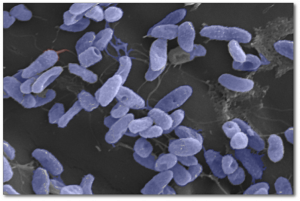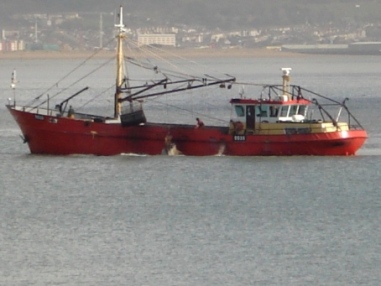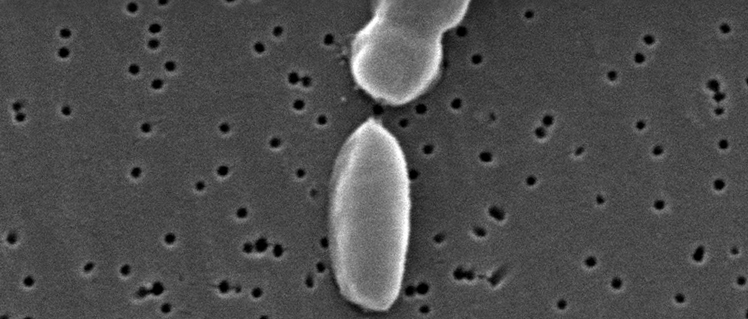Interactions
Vibrio parahaemolyticus goes through interactions with several other organisms including mollusks, bacteriophages, and humans.
In mollusks, bacterium in the Vibrionaceae (like V.
parahaemo lyticus)
family were found in the gut of the bivalves sampled. The
bivalves use bacterium as food as adults and larvae.
Vibrios were also found in the adjacent tissue of the gut of
these bivalves. Although, the bacterium were found to be
in higher numbers in the digestive tract rather than the tissue.
Compared to the surrounding sea water, the species of bivalves
had a much higher concentration of Vibrio bacterium.
These bacterium can consume the dissolved organic material put
out by the mollusks. However, the relationship between
bacterium and bivalves releasing and consuming dissolved organic
material is very complex. There is still much more
information needed to be found to come to a conclusion.
The
snow crab is an example of another organism that V.
parahaemolyticus would interact with.
lyticus)
family were found in the gut of the bivalves sampled. The
bivalves use bacterium as food as adults and larvae.
Vibrios were also found in the adjacent tissue of the gut of
these bivalves. Although, the bacterium were found to be
in higher numbers in the digestive tract rather than the tissue.
Compared to the surrounding sea water, the species of bivalves
had a much higher concentration of Vibrio bacterium.
These bacterium can consume the dissolved organic material put
out by the mollusks. However, the relationship between
bacterium and bivalves releasing and consuming dissolved organic
material is very complex. There is still much more
information needed to be found to come to a conclusion.
The
snow crab is an example of another organism that V.
parahaemolyticus would interact with.
 Bacteriophages
also have an interaction with this bacterium. They are a
virus that infects bacterium and lyse, or burst, the cell.
The phages for V. parhaemolyticus originate from Vibrio
spp. and not Vibrio parahaemolyticus or Vibrio
alginolyticus. It is not known if phages are
influenced by the bacterial population or the possible chemical
and physical factors in the environment. In a study done (Baross
et al. 1978) it was shown that bacteriophages for V.
parahaemolyticus occur much more often in marine animals
compared to seawater and sediments. The most phages were
found in oysters, whereas the seawater had the least. The
test resulted in 37% of the bacterium with phages. An
interesting point made was that it was not unusual to isolate
phages from V. parahaemolyticus from seafood samples at
a market. Just as V. parahaemolyticus does,
numbers of bacteriophages increase with warm weather. The
bacteriophage does not increase due to the number of V.
parahaemolyticus bacterium.
Vibrio
alginolyticus is a bacterium that could be closely
related to V. parahaemolyticus due to its bacteriophage.
Bacteriophages
also have an interaction with this bacterium. They are a
virus that infects bacterium and lyse, or burst, the cell.
The phages for V. parhaemolyticus originate from Vibrio
spp. and not Vibrio parahaemolyticus or Vibrio
alginolyticus. It is not known if phages are
influenced by the bacterial population or the possible chemical
and physical factors in the environment. In a study done (Baross
et al. 1978) it was shown that bacteriophages for V.
parahaemolyticus occur much more often in marine animals
compared to seawater and sediments. The most phages were
found in oysters, whereas the seawater had the least. The
test resulted in 37% of the bacterium with phages. An
interesting point made was that it was not unusual to isolate
phages from V. parahaemolyticus from seafood samples at
a market. Just as V. parahaemolyticus does,
numbers of bacteriophages increase with warm weather. The
bacteriophage does not increase due to the number of V.
parahaemolyticus bacterium.
Vibrio
alginolyticus is a bacterium that could be closely
related to V. parahaemolyticus due to its bacteriophage.
There is also a parasite linked to Vibrio parahaemolyticus.
This parasite's name is Bdellovibrio and it is also
halophilic. Bdellovibrio grows best in 25°
Celsius to 30° Celsius. In natural sea water, this
parasite can be up to 10 times the number of V.
parahaemolyticus. This parasite was lethal to V.
parahaemolyticus.

The interaction that V. parahaemolyticus has with humans is very complex. In layman's terms, the thermostable direct hemolysin (TDH) causes hemolysis. This specifically targets erythrocytes, red blood cells. The hemolysin also creates a higher concentration of calcium cations in red blood cells. It increases the cation influx in the blood. TDH increases chlorine anion secretion in human colonic tissues as well. Vibrio parahaemolyticus and its toxin, TDH, cause gastroenteritis in humans.
To learn fascinating facts about Vibrio parahaemolyticus and its history check out the Facts!
